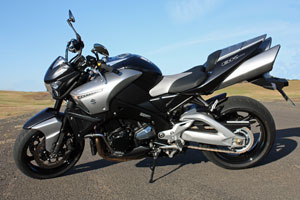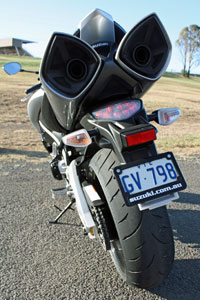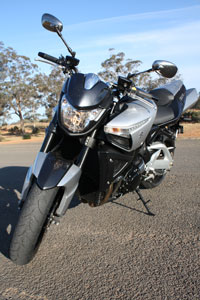Suzuki’s 2009 model B-King has all the power you could ask for, but surprises in so many other ways. Come for the ride with MotoOnline.com.au.

SUZUKI B-KING SPECIFICATIONS
ENGINE
Engine type: Four-stroke, four-cylinder, DOHC, 16-valve, liquid-cooled
Bore x stroke: 81 x 62mm
Displacement: 1340cc
Compression ratio: 12.5:1
Transmission: Six-speed
Power: 174hp
Torque: 103ft-lbs
CHASSIS
Frame type: Aluminium-alloy, twin-spar frame
Front suspension: Kayaba 43mm, USD, fully adjustable forks
Rear suspension: Monoshock, fully adjustable
Wheelbase: 1525mm
Wheels (front/rear): 17 x 3.50 / 17 x 6.00
Tyres (front/rear): 120/70R17 / 200/50R17
Brakes (front/rear): Nissin duel 310mm discs, four-piston calipers / Tokico 260mm single disc and piston caliper
DIMENSIONS
Weight (claimed): 235kg
Seat height: 805mm
Fuel capacity: 16L
PURCHASE DETAILS
Price: $18,990 + orc
Warranty: 24 month, unlimited km
Colour options: Grey/Silver or Matt Black
Test bike from: Suzuki Australia – www.suzuki.com.au
Suzuki’s B-King. I’ve seen it, read about it, and even wondered about it at times, but to be honest, testing this monstrous 1340cc inline four-cylinder had never really crossed my mind.
As a chief sportsbike tester mainly putting the latest and greatest 600cc and 1000cc sporties through their paces during my duties with Australian Motorcycle News, the B-King was never truly on the cards for me.
But launching MotoOnline.com.au has opened up a bold new world for me, testing a range of motorcycles I otherwise wouldn’t be, and when Eoin Black from Suzuki Australia called with the offer of testing the B-King I simply jumped at the opportunity.
The reality of what I had gotten myself into set in when the bike couriers dropped off the bike, delivering a massive weapon that seemed to have doubled in size since I last sat on one in a Suzuki dealer.
Despite it’s size, the B-King has a number of sporty significances to it, including the Kayaba upside-down forks, Kayaba monoshock, Nissin front brakes, Tokico rear brakes, and even Dunlop Sportsmax Qualifier tyres, not to mention the sporty riding position.
More relaxed than your average sportsbike, the B-King does still have a sporty feel once in the saddle, with a comfortable reach to the medium-set handlebars complimented by footpegs that are set slightly back compared o most large-capacity naked bikes – resulting in a sports feel that sets the bike up for beautiful handling.
The B-King’s engine stems from that mounted in the fully-faired Hayabusa, and delivers a whopping 174 horsepower at the rear wheel, along with a bucklet load of torque at 103 ft-lbs.
First things first, my initial plan for the ride was to see what the engine’s really got, to see how angry I could make it, and to see if all of the hype that I’d ever heard about bikes of this capacity was on target.
Surprisingly, it wasn’t what I expected. Expecting a power horse with an aggressive nature, I was pleasantly greeted by a powerband that’s astonishingly smooth from initial throttle application to around the 90000rpm mark where it tends to drop off, proving fast, but very useable in every instance.
Where I thought I’d be fighting to hold on to the ’bars, sometimes I’d find myself hoping for a greater surge of power, soon realising that second and third gears are the key if you want a more exciting ride, while fourth and above are all extremely courteous in their nature.
What about first, you may be wondering. Well, it’s quite tall and is easily capable of reaching 120km/h if you like, but the grunt to pull wheelies despite its weight of 235 kilograms is what really keeps you entertained, causing a massive smile inside my helmet each time the front wheel would loft with just a slight pull on the ’bars under power.
Typical of the Suzuki GSX-R range that I’ve been so fond of in the past, the fuelling and throttle application on the B-King are brilliant, as is the gearbox in its operation, especially at lower revs.
There are two options for the engine mapping, featuring A mode as the most powerful, and as with its sportier siblings, you’ll easily get the most enjoyment out of the full power mode over the tamer secondary mode.
These modes operate from a number of buttons situated on the large fuel tank, while the dash features the almost customary analogue tacho with a digital readout of speed, duel trip-metres, gear indicator, fuel and temperature gauges, and a clock. There are also the usual assortment of warning and indication lights, all amounting to what is a good looking dash, even if it’s a little plain in its two-button operation.
Ride the B-King high in the revs and you’ll find yourself squirming under power as the Dunlops fight for their lives, but be gentle with it and you’ll be rewarded with an impossibly friendly companion each step along the way – there really are two sides to this bike.
I personally like to keep it revving hard and pushing along, but be careful because the power output can almost instantly raise you above any speed limit, so you’ve got to be selective in your throttle twisting surges.
As indicated above regarding the seating position of the bike, it’s sporty and sharp, even with its massive tank and exhaust pipes that stand out beneath the rear ducktail, giving the bike a look that you’ll either admire or think it’s desperately ugly.
I’m of two minds. One part of me likes the individuality of the ride, while the minimal front-end of the ride is very much overshadowed by what hangs out the rear end.
Either way, it’s your choice, and the build quality is exactly what you’d expect from Suzuki and pretty much all of the leading Japanese manufacturers these days.
Once good thing to keep in mind is that the mirrors are in a good position, highly useful and easily adjustable for the ride.
The size of the bike shrinks once you click it into gear and release the clutch, instantly becoming quite a nimble bike in regards to its sheer size, and riding it proves much easier than trying to wheel it in and out of the garage where you can feel every damn kilo of it.
It’s easy to ride in traffic, although you can feel the size at each traffic light as you strain the leg muscles holding it upright, and low-speed riding is incredibly nice as you work your way out to the open roads where it belongs.
This is where you’ll fall in love with the capabilities of the B-King, enjoying its handling on long, sweeping bends, with stability at speed very good on smooth or bumpy roads – with the standard steering damper adding to the confidence.
Bumps are a little harsh on the front-end and it tends to bounce off the sharp ones, but there was only a couple of times where the bike was actually put off my selected line because of this, easily allowing me to readjust to where I wanted to be on the road.
While set quite stiff for turning, under brakes and cornering on smooth roads was brilliant as the stiffer settings allow you to push without the weight upsetting the ride too much, and I’d much prefer a bit of deflection off of the bumps that having too much shifting of the weight if the forks were too soft under normal circumstances.
Speaking of braking, wow! This is probably the most impressive aspect of the B-King as you can slow from warp-speed to slow in split-seconds by squeezing the great felling front lever, that’s matched by a consistent feel at the rear.
Time after time I found myself amazed at its stopping power and predictability with its weight, enabling me to ride with confidence on a bunch of roads that I had never previously sampled.
Transitioning from speed to slowing under brakes is smooth and controlled, maintaining stability, and the lean-angle that you can carry on the B-King adds to its sport-orientated feel.
The rear of the bike is a little more forgiving in its setting than the front, moving and squatting a touch under heavy acceleration, but offering supreme feel of where the tyres were at.
After receiving the bike from AMCN after Matho and co. had taken it for a spin, you could see the wear on the tyres, especially the front, and this continued after my few hundred kays in the pilot’s seat – probably because of the outright weight of the bike, along with its sporty nature.
Overall it’s a very practical bike apart from when you’re wheeling it around in the shed, as vibrations are minimal, the controls are adjustable, and the seat for the long haul is more than comfy enough.
There’s a handy bumstop that comes into play when you’re well and truly on the gas, and plenty of room to move around the bike no matter your height or weight.
Suiting riders who are looking for big power, great comfort, and relatively good handling in sportsbike terms all things considered, the B-King has a serious appeal to it that will most likely be decided by the simple fact of wether or not you like it’s look enough to lay your hard earned cash down after a test ride.
At $18,990 plus on-roads, it’s a very affordable price, and you can bet your money that once you test ride one of these rides you’ll find very little to fault on it unless you’re after VMAX-like grunt and the price that goes with it.
Sure, the exhaust note could be tougher, looks could be a touch slimmer, and dash could be more energising, but at the end of the day you’re getting a whole heap of performance for your dollars.
Suzuki’s done an exceptional job with the B-King, continuing its tradition of excelling in the naked sports market, and this particular test has again broadened my horizon as an all-round motorcycle test rider.
Now, I wonder what Eoin’s got up his sleeve for me to test next? Perhaps Suzuki’s heavily speculated GS1000R litre-size sportsbike, eh? Whatever it is, I can’t wait.










Newsletter